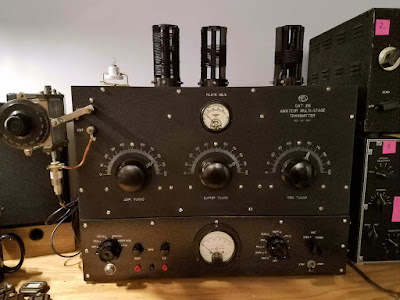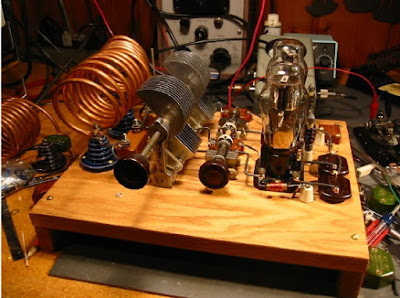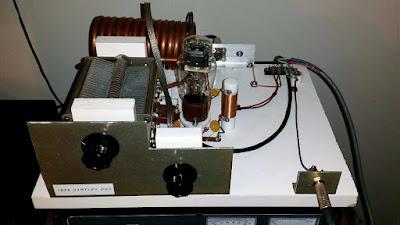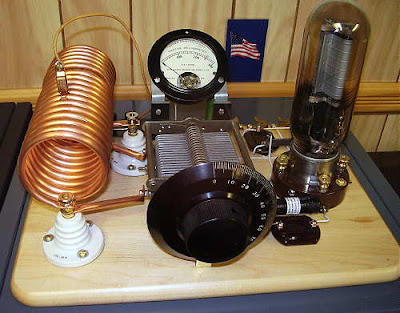 Some more oldies, but goodies
Some more oldies, but goodies
For those of you with a kindle, these can be download for FREE from Amazon.
1. The Radio Boys’ First Wireless
https://www.amazon.com/gp/product/B008476T3S/
2. The Radio Boys at Ocean Point
https://www.amazon.com/gp/product/B004TSAZWM/
3. The Radio Boys at the Sending Station
https://www.amazon.com/gp/product/B004TQF6BE/
4. The Radio Boys at Mountain Pass
https://www.amazon.com/gp/product/B006T5TLSM/
5. The Radio Boys Trailing a Voice
https://www.amazon.com/gp/product/B004TRF6S6/
6. The Radio Boys on the Mexican Border
https://www.amazon.com/gp/product/B004TIJRP8/
7. The Radio Boys on Secret Service Duty
https://www.amazon.com/gp/product/B00AQMGFB0/
8. The Radio Boys in the Thousand Islands
https://www.amazon.com/gp/product/B00AQMZS86/
9. The Radio Boys’ Search for the Inca’s Treasure
https://www.amazon.com/gp/product/B004Z0MNBU/
10. The Radio Boys Rescue the Lost Alaska Expedition
https://www.amazon.com/gp/product/B0058KSAW2/
11. Radio Boys Cronies
https://www.amazon.com/gp/product/B00848O6YQ/
12. Radio Boys Loyalty: Bill Brown Listens In
https://www.amazon.com/gp/product/B004TRO448/
13. The Radio Boys with the Revenue Guards
https://www.amazon.com/gp/product/B004UKEU2A/
So yeah, the stories are a bit campy, perhaps and the language and slang is old - but what the heck? They're free and they're almost 100 years old!
I downloaded them all to my kindle and am enjoying them. I hope you will, too!
72 de Larry W2LJ
QRP - When you care to send the very least!
Larry Makoski, W2LJ, is a regular contributor to AmateurRadio.com and writes from New Jersey, USA. Contact him at [email protected].
 HAPPY NEW YEAR…..I have a plan
HAPPY NEW YEAR…..I have a plan
Mike Weir, VE9KK, is a regular contributor to AmateurRadio.com and writes from New Brunswick, Canada. Contact him at [email protected].
 A little dated
A little dated
The Archie comic book issue devoted to Amateur Radio - https://kk4dsd.files.wordpress.com/2013/09/archies_ham_radio_adventure.pdf
I don't know if kids read comic books, anymore - other than graphic novels. I was past kidhood when this first came out. As one who DID read Archie comics at one point, I can confidently say, that had it come out when I was a youngster, it would be dog-eared, and practically worn out from being read so much!
Hope it stirs some fond memories for you!
72 de Larry W2LJ
QRP - When you care to send the very least!
Larry Makoski, W2LJ, is a regular contributor to AmateurRadio.com and writes from New Jersey, USA. Contact him at [email protected].
 Over and (not quite) Out – KN4AQ and HamRadioNow
Over and (not quite) Out – KN4AQ and HamRadioNow
[this blog entry originally… well, seconds ago… appeared as a QLOG blog post on the HamRadioNow.tv web site]
If you watched all of HamRadioNow 377, BS#11: ARRL, CQ, Happy New Year you saw my most direct statement that I’m going to leave the show in the hands of my co-host (now full host) David Goldenberg W0DHG. Thanks for the many comments about the show so far, and the ‘don’t go’ requests.
When I finished that show, I felt kind of sad. I’d be sadder if it were really my last show, but I’ll be around a while longer. I’ve committed to go to Orlando in February with a booth in Commercial 3, and I’m planning on a SIB (Studio In a Booth) there. It’ll be nicer than tent city in Xenia. I’m also planning on going to Dayton to shoot some forums, but no booth. Maybe a little tour. The 2018 TAPR DCC in September will depend on a pretty expensive KICKSTARTER (I’m guessing $8000) that I’ll run in June.*
David is getting close to finishing the ‘West Coast Studio’ and being able to run shows on his own. Then the show will take his direction entirely. I’ll be happy to show up as a co-host now and then, but I’m eager to see how David develops as an ‘on-air talent’. It will put him on level ground with most of the other ‘HamCasters’ out there who didn’t come from a professional media background. Only a few did – I’m thinking of Don Wilbanks AE5DW (Ham Nation and Newsline), Valerie Hotzfeld NV9L (Ham Nation), Cale Nelson K4CDN (Ham Radio 360), Neil Rapp WB9VPG (HamTalkLIVE), and some more of the Newsline contributors and anchors who don’t do podcasts. I probably missed a few, and OK, that’s more than I thought, but there are a lot of shows out there by ‘amateur amateurs’.
As I mentioned on the episode, I’ve got plans for a show that’s not ham radio related. My own background started in the ‘general media’ broadcast biz, with stints on-air at several radio stations. I always preferred doing that, but always made a far better living with my video and audio production talent than my on-air talent. I almost got hired to do a talk show out of WMBD radio in Peoria IL in 1986. I could have been Rush Limbaugh instead of Rush Limbaugh, and the whole political landscape could be different today. So it was my fault. OK, dream on, and Rush started his talk show in Sacramento CA in 1984, so I would have had some catching up to do. I didn’t take that job, and it’s a longish story. But coulda woulda.
As I dipped my toe into producing some ham radio videos, I didn’t appear on-camera much. I did short on-camera intros for The Last Big Field Day and Digital Voice for Amateur Radio DVDs, but the rest was voice-over, with the usual ‘invisible producer’ interviews. Even my first Hamvention Tour DVDs starting in 2007 used Jeff AC4ZO on camera more than me. It took a while to build the confidence to step into the spotlight completely.
One of my goals when I started ARVN:Amateur Radio//Video News… a clunky name that became HamRadioNow… was to get more professional video media into ham radio. At the time, ham media was mostly magazines, while video/television was seeping into corporate communications and other non-broadcast interest areas.
CQ had tried making some videos (professionally produced, and released on VHS) in the early 90’s. Video production was extremely expensive back then. A decade later, when I bought a camera and shot The Last Big Field Day, it was DIYish (after spending about $15,000 on my first camera/mic/editing system). I didn’t know it, but George W5JDX was starting AmateurLogicTV about the same time, with way cheaper gear and lower production ‘values’, and putting it on the web instead of DVD. I missed that boat for almost a decade
Before starting, I sought advice from two friends in ham media. Rich Moseson W2VU, who produced the CQ video series and went on to become CQ editor, discouraged me. He considered the CQ videos an expensive and somewhat failed experiment—failed in that they weren’t embraced by the ham community enough to be commercially profitable. Let’s put it this way: they didn’t go on to make a second series. At that time (early 90’s), video production was either really bad amateur stuff (badly shot and edited on VHS), or very expensive professional work. CQ opted for pro. I think it would have looked bad for them to do take the schlock route.
Bill Pasternack WA6ITF (SK), on the other hand, was highly encouraging. Like me, Bill (co-founder of Newsline) had longed to see ham activities documented more professionally. Newsline was a shoestring audio production. It was all volunteer, with just enough financial backing from the audience to keep it limping along year-to-year.
Bill was also part of the team that produced a handful of ham radio films (yes, films), with Roy Neal K6DUE and Dick Van Dyke, and later one with Walter Cronkite, mostly a labor-of-love with modest financial support from the ARRL. As a broadcast video engineer, Bill saw ‘pro-sumer’ video equipment getting better and cheaper, but he was frustrated that the Amateur Radio Today video he produced with Cronkite had little actual footage covering ham operation, particularly EmComm (the video focused on California fires that year, and they had to stage much of what they used). Bill dedicated one of his Town Hall forums at Dayton to encouraging hams to shoot and edit video with the new tools whenever and wherever they could, especially during EmComm operations. So far, that’s not happening.
Bill believed that someone with my technical background could maybe pull it all together. I miss Bill. I was looking forward to many more BS episodes with him on HamRadioNow.
Neither Rich nor Bill was fully right or wrong. Production get did get cheap enough that I could produce videos that looked as good as CQ’s series for probably 10% of their cost. But the ham community still did not embrace them enough to make them a business. My goal (and Bill’s hope) was for a program that could document and present ham radio professionally, both for ham ‘internal consumption’ and to provide grist for the general media mill to tell our story. It wasn’t happening.
Ham Nation appeared on the TWiT network in 2011. Bob Heil brought in one of Ham Radio’s biggest ‘stars’, Gordon West WB6NOA, and asked me to guest-host when he was on the road. Then he discovered George W5JDX from his Amateur Logic series. I suggested they try to incorporate Newsline into the program with a short peek at upcoming headlines, and initially Bob Sudock WB6FDF did the job (but it was never ‘upcoming’ headlines. It was and still is leftovers from the previous week. Have I mentioned that video production takes time?). Bob had health problems, and the Newsline job fell to Don Wilbanks AD5DW. Don’s a total pro, and quickly became a regular part of the full show. I’ll say that Don ‘took my job’ as guest host and leave the long story at that.
I’m gonna also say that in some ways Ham Nation ruined ham radio’s chance at the professional production Bill Pasternack and I had hoped for. The popular show sucked much of the air out of the room for ham media with a low-production-value happy-talk style that put ‘amateur’ back in ‘amateur’ (OK, it never really left). They do some Skype interviews, sometimes newsworthy and sometimes really interesting, but never hard-hitting. They get some videos contributed by viewers with variable quality (and for the ‘big’ show, they don’t get flooded with videos). The most popular segments are about building stuff, a ham staple that lots of other shows rely on and I’ve stayed mostly away from (my Episode 82: Dipole with over 32,000 views is among my most popular, so no, I don’t learn lessons). We don’t know how popular Ham Nation really is because TWiT doesn’t release statistics. Their YouTube channel shows view counts in the 2 to 4k range (with spikes above that), but YouTube is only one outlet, and if that’s just a fraction of the viewers and listeners, we’re looking at 10k or more… maybe in the 20 to 30k range.
TX Factor
There is one show out there that does produce very professional ham media: TX Factor. It’s a British production that began in February 2014. While they cover the usual ham stuff, they do it in a magazine show style (three to five segments in their 40 to 60-minute show… they’ve been getting longer…) that are all shot on location, edited and packaged. It’s a lot of work, as evidenced by the fact that in four years they’ve produced only 19 episodes. They also shy away from controversy, though they’ll occasionally note that something is a bit off here and there.
ARRL… QST-V?
I didn’t intend to do a full media review when I started writing this blog entry, but I should mention the League’s lack of participation. They’ve made a few video programs in addition to equipment reviews and now the Doctor Is In podcast (excellent, by the way). But they’ve never built a TV studio or produced a regular video program, even though they concentrate almost everything going on in ham radio in one building in Newington (and could Skype in the rest). Nor do they go out of their way to get their staff to appear as guests on the many talk-format shows out there. I was able to get some of their leadership on HamRadioNow for a while, but that seems to have stopped when I proved not to be a reliably friendly venue.
Money is a issue at HQ, but I’ll just say that if I can do it with my limited, individual resources, it’s not the main issue. Clearly they don’t see value… a cost/benefit calculation. At least not yet.
Meanwhile I have seen some good stuff from the RSGB (with help from TX Factor). Nothing regular yet, but more than the League has done.
The one area that has consistently produced high-quality video programs are the ones coming from DXpeditions. Not all are top notch, but Bob Allphin K4UEE and James Brooks 9V1Y have led the field in all amateur radio video production. And I’m not saying that just because I edited Bob’s Navassa DXPedition video. And sorry, they’re not online. You gotta buy the DVDs (a few of the old ones have found their way to YouTube). You can watch James’ excellent WRTC 2014 documentary online. That this is the case shows where the money is in ham radio media.
So as my car on the HamRadioNow train approaches the terminal, I’ll say that it’s been very rewarding (emotionally, not financially). I look back over the nearly 400 shows (over 400, if you count the many multi-part episodes), I can’t believe where I got the ambition to do it. And I’m generally happy (sometimes very happy) with my ‘performance’ on-camera. Happier than most of you are, it seems. It is a vanity and ego-driven business, after all. I’m sorry I didn’t get to do what I set out to do – the documentary style programs that TX Factor does – here in the US. I’m sorry that nobody in ham radio has found a way to make a business out of ham video, and maybe the hobby is just too small for that. Maybe it’s just not possible, and all our ‘new’ media will continue to be in the DIY/vanity category.
But I’m not sorry I tried. If I hadn’t done this, I probably wouldn’t have tried doing what’s next.
73, Gary KN4AQ
*And I’ll leave it to motivated TAPR enthusiasts to promote and make the KICKSTARTER successful. It’s not that I don’t want to go, but at this point it will be a business proposition that covers expenses and editing (highly discounted editing). Think of it as you’re hiring me to do it, not that I’m just asking for some support.
Gary Pearce, KN4AQ, is the host of HamRadioNow.tv. If you enjoy this and other HamRadioNow programs, help keep them 'on the air' with a contribution. Contact him at [email protected].
 Ham College 36
Ham College 36
Ham College episode 36 is now available for download.
General Amateur Radio Exam part 7. More operation discussion. More Impedance questions.
01:13:00
George Thomas, W5JDX, is co-host of AmateurLogic.TV, an original amateur radio video program hosted by George Thomas (W5JDX), Tommy Martin (N5ZNO), Peter Berrett (VK3PB), and Emile Diodene (KE5QKR). Contact him at [email protected].
 Happy New Year – 2018
Happy New Year – 2018
May 2018 always be in VFO A.
May 2017 always be in VFO B.
May you get all those ATNOs that 2018 has to offer.
May you get that new piece of gear that you've been dreaming about.
May the bands favor you with the most agreeable conditions.
May your friendships and your enjoyment of the hobby always increase.
May your worries and cares always decrease.
Larry Makoski, W2LJ, is a regular contributor to AmateurRadio.com and writes from New Jersey, USA. Contact him at [email protected].
 The “BK 1929 QSO Party” From BC
The “BK 1929 QSO Party” From BC
 With this being my final blogspot of 2017, let me take this opportunity to wish all readers and radio friends season's greetings and good health and happiness in the coming new year. It's hard to believe that this is blog posting #470, having started blogging in the spring of 2014 ... how time flies when you're having fun. It flies even quicker when your both old and having fun at the same time!
With this being my final blogspot of 2017, let me take this opportunity to wish all readers and radio friends season's greetings and good health and happiness in the coming new year. It's hard to believe that this is blog posting #470, having started blogging in the spring of 2014 ... how time flies when you're having fun. It flies even quicker when your both old and having fun at the same time!The AWA's annual premier operating event, the "Bruce Kelley 1929 QSO Party", affectionately known as the "BK", has once again come and gone and some have already begun the countdown to next year's fun!
The hoped-for good conditions, not seen in the past few years, almost became a reality as it wasn't a complete washout like last year's event. Spread over two consecutive Saturday evenings, the best conditions were on the second night, but with just a few east coast stations making it into the log. Several of the 'eastern regulars' were just never heard here, as the band was not quite up to par ... maybe next year will see a return to the great low band conditions of the past.
As usual, I began on 40m, shortly after the BK start at around 1500 local time, and a good hour and a half before local sunset. Usually, 40m isn't too productive until closer to sunset and then, only briefly, as eastern stations have usually moved down to 80m just as the band opens up out here. Contacts with KØPK (MN) and K4JYS (KY) were followed by exchanges with locals VE7BDQ (John) and new BK'er VE7CNF (Toby).
As always, K4JYS's 1929 designed Hartley oscillator using a 210 at 20W input, made it up to this region consistently and was 559 with over an hour of daylight remaining.
 |
| K4JYS's 210 Hartley |
John and Toby both chose to build relatively rare 1929 designed Colpitts oscillators and were both exceptionally strong here.
 |
| VE7BDQ's Colpitts 45s |
 |
| VE7CNF's Colpitts 45s |
Here is a recording of VE7CNF's Colpitts on 80m thanks to Mark, VA7MM.
KK7UV, Steve in Montana, called in next, using his painstakingly restored REL MOPA (Master Oscillator Power Amplifier). His 5W input was a solid S7 here.
 |
| KK7UV's REL |
Moving down to 80m just after 1700 local time, netted contacts with WB9WHG (WI), KØSM (NY), W2ICE (NY), WA9WFA (MN) and W8KGI (NM) all before dinner hour.
I think Scott (WA9WFA) may be the only other Colpitts user and was a solid 569 here using his pair of 10s at 20W input.
 |
| WA9WFA's Colpitts '10s |
The band slowly deteriorated later in the evening but not before working N4GJV (NC) on his 3W Hartley oscillator and then finishing with back to back contacts with KØPK and KØKP, both in MN.
 |
| KØKP's Hartley '10 |
Weekend two started again in daylight on 40m, with the 25W Hartley signal of W2AN in New York booming into Mayne Island at 589! Truly remarkable with sunset being over 30 minutes away. What looked to be a really good night shaping up turned out to be disappointing once again ... but for a few strong 'spotlight' openings to the east, most east coast signals evaded me once again.
| W2AN's Hartley 203A |
Back on 80 right at sunset brought W2AN (NY) once again followed by WØNYQ (MN) with his 4W TNT doing a nice job at 569.
 |
| WØNYQ's 4W TNT with a 245 |
80m contacts were completed with N8YE (OH), NO3M (PA), W3GMS (PA) and the highlight of the evening, N2OUV, Joe in NY, running his 10W '29 Hartley and peaking 579 on the transcontinental path. I rarely work Joe but when I do it's always a delight as it was his YouTube video that originally inspired me to become a '29 builder and participant!
 |
| N2OUV's 211 Hartley |
Hats off as well to Joe, W3GMS in PA whose rare original 18W TNT was putting an impressively solid signal into the west coast for over an hour ... he must have a great antenna.
 |
| W3GMS's Original '29 210 TNT |
Once again, I used my homebrew MOPA using type '10s for all contacts but I could have just as readily used my Hull Hartley or TNT as there was absolutely no wind on either weekend ... a very rare happening here on the ocean!
 |
| VE7SL's '10 MOPA |
One great positive was the appearance of several newcomers to the '29 Party, which seems to be growing in popularity each year. There is still a lot of interest in '29-style construction it would seem and if this is something that you might like to try for next year's event, here are some helpful guidelines from some of my previous blogs to help get those homebrew juices flowing. It's never too early to warm-up that soldering iron!
There is also some hands-on '29-style building info on my website that can be reached here.
While you are at it, don't forget to sign onto the AWAGroup of '29 Builders as there is plenty of help, discussion and good advice waiting for you there.
Hopefully we will see YOU and your new '29 transmitter next year along with those expected great band conditions!
Steve McDonald, VE7SL, is a regular contributor to AmateurRadio.com and writes from British Columbia, Canada. Contact him at [email protected].

















